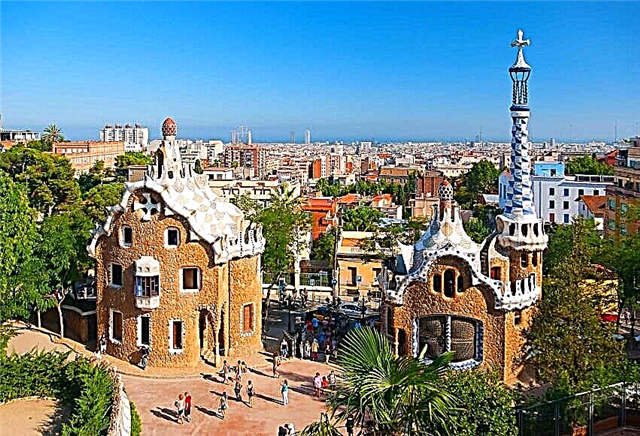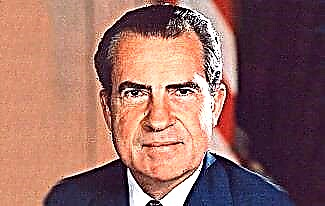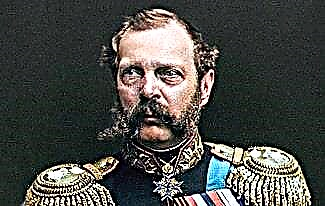The name of this city is often shortened to “Ensk” or “N-City”. Sign of the times - before the length of the name sometimes spoke of the status of the city. The two-syllable “Moscow” breathed with patriarchy, boyar hats and other austerity, but “St. Petersburg” breathed progress with its rhythm. Exactly also in the names "Novo-Nikolaevsk" and "Novosibirsk" one can hear the sound of the wheels of trains crossing the immense state from west to east or in the opposite direction.

Novosibirsk can rightfully be considered the capital of Russian Siberia. The largest airport and the largest railway station in the macroregion are located in Novosibirsk. The city is home to ancient monuments and masterpieces of modern engineering. It is the capital of the Siberian Federal District and at the same time looks like a provincial regional center. This is the whole of Novosibirsk: the city is growing so fast that it outgrows its clothes faster than the capital.
1. The present-day Novosibirsk had 6 “preliminary” names. The settlement was called Nikolsky Pogost, Krivoshchekovo, Novaya Derevnya, Ob, Novo-Nikolaevsk, and Novo-Sibirsk with a hyphen.

2. Novosibirsk is very young. The city dates back to 1893. This year, a settlement was founded, in which the workers who were building a bridge across the Ob lived. The Trans-Siberian Railway crossed the bridge. However, the youth of Novosibirsk does not indicate that people did not live here before the construction of the railway. The most convenient place for crossing the Ob River is located in the Novosibirsk region, hundreds of kilometers upstream and downstream. Excavations indicate that there was even a mammoth migration route here, which means that hunters lived. In the Middle Ages, the state of Telengutia was located on the territory of the present Novosibirsk and Kemerovo regions. It is glorious in that it became the only state entity in Siberia with which the Moscow tsars negotiated and signed a peace treaty. In 1697, the Tomsk voivode Vasily Rzhevsky ordered the official for special assignments Fedor Krenitsyn to build an inn on the left bank of the Ob. A scar from a saber blow passed through the entire face of Krenitsyn, so he was called Krivoschek behind his eyes. Accordingly, the inn and the settlement that arose next to it became the village of Krivoshchekovskaya. Officially, the village was named Nikolaevsk - in honor of the patron saint of travelers.

3. Novosibirsk is growing very quickly. Just 60 years after its foundation, it became a millionaire city, for which it was awarded the entry into the Guinness Book of Records. The population of 1.6 million people makes it the third largest municipal entity in Russia and the first in terms of population in the country. Since 2012, the population of Novosibirsk has been continuously increasing by 10,000 - 30,000 people a year. In addition, about 100,000 people, who are not formally residents of the city, come to Novosibirsk to work.

4. Among Novosibirsk historians, ethnographers and journalists there is a considerable stratum of revisionists - people who consider the official history of the city incomplete or distorted. Some of their versions seem very likely. For example, the version about the construction of Novo-Nikolaevsk as a reserve or a new capital. There are many interesting facts that indirectly confirm this possibility. Novonikolaevtsy received a satisfactory answer to their petition for recognition of their settlement as a city very quickly. The decoration for the temple in the name of Alexander Nevsky was prepared personally by the empress and the grand duchess. Prime Minister Pyotr Stolypin came to Novo-Nikolaevsk on an inspection visit and demanded to pave the streets. Have Russian premieres visited and do many "non-county" cities? The Trans-Siberian Railway crosses 16 large rivers, and a large city arose only at the bridge over the Ob. The facts are really thought provoking. But the revisionists immediately begin to attach to them some ancient kingdoms, great civilizations, to look for toponymic and linguistic coincidences, etc., by which they themselves discredit all their research.
5. Red Avenue - the central street of Novosibirsk - once served as a landing strip for an airplane. On July 10, 1943, the engine of the pilot Vasily Staroshchuk had an engine failure during a test flight. At this moment, Staroshchuk's plane was directly above the city center. Staroshchuk realized that he did not have enough height to take care of the city, and decided to land the plane on Krasny Prospekt. Unfortunately, the landing ended in disaster - the plane collapsed, the pilot died. However, Staroshchuk's strategic decision was correct - no one, except the pilot, was hurt.

In 2003, the pilot's feat was immortalized with a monument. Another flight accident in Novosibirsk ended with a much more tragic result. On September 28, 1976, the pilot of the An-2 aircraft Vladimir Serkov sent his car to the house where his father-in-law and mother-in-law lived - family relations did not work out. The father-in-law with the mother-in-law was not at home, and Serkov missed, falling into another apartment. After hitting the wall of the house, the plane collapsed and a fire started. Serkov himself and 11 other residents of the house died.

Consequences of the terrorist attack by Vladimir Serkov
6. According to users of one of the most popular tourism and travel sites, the Novosibirsk Zoo is one of the ten best in Europe. The names of Mikhail Zverev and Rostislav Shilo are inscribed in golden letters in the history of one of the largest zoos in Russia. Zverev, better known as a children's writer and scientist, created a prototype of the future zoo out of sheer enthusiasm. Studying with young naturalists, he first started a living corner, then broke through its extension to the zoological station, at the same time receiving a large plot of land for the future zoo. This was back in the pre-war years. During the war, animals were evacuated to Novosibirsk from zoos located in the European part of the Soviet Union. For a long time, the Novosibirsk Zoo developed neither shaky nor shaky, until in 1969 Rostislav Shilo became its director, who began his career as a cage cleaner. Shilo's stormy activities were not interfered with by either the power perturbations, or the collapse of the USSR and the collisions associated with it. The Novosibirsk Zoo has been continuously improving and expanding, and at the same time has become a base for numerous scientific research. In it, for the first time in history, the offspring of a river otter, a white leopard, a musk ox, a takin and a polar bear were obtained. In Novosibirsk, they managed to cross a lion and a tiger, having received a liger. Now the Novosibirsk Zoo is home to over 11,000 animals belonging to 770 species. It is visited by 1.5 million people annually. Together with the zoos of San Diego and Singapore, the Novosibirsk Zoo is one of the zoos whose activities are paid off by ticket sales and other own income.

7. There is a fairly widespread legend about how Novosibirsk lived simultaneously in two time zones: the time on the right bank corresponded to Moscow +4 hours, and on the left - Moscow +3 hours. This legend was especially popular during the time constraints on the sale of alcoholic beverages in the Soviet Union. They say that wine and vodka shops on the right bank have already closed, but you can have time to hit the road to the left bank. In fact, such a time collision existed only at the beginning of the twentieth century, but then the transport connectivity of the Ob banks was very weak, and the time difference affected a very small number of people. Since 1924, all of Novosibirsk lived according to the time of Moscow time + 4. The border of this time zone passed approximately in the area of Tolmachevo airport. Gradually the city expanded, and the border had to be pushed back again. In 1957, they did it simply - they included the entire Novosibirsk region in the time zone MSK + 4.
8. In 1967 the Glory Monument was opened in Novosibirsk. This memorial complex, originally composed of five pylons symbolizing the war years and a sculpture of a woman mother, is constantly evolving. Over the past half century, a park of military equipment, a memorial to the Knights of the Order of Glory, steles with lists of Heroes of the Soviet Union and a list of Siberian divisions have been added to it. The Monument also includes an obelisk in the form of a sword, symbolizing the unity of the front and rear, and commemorative steles with the names of Novosibirsk people who died during the conflicts in Afghanistan, Yemen, Vietnam, Kampuchea, Chechnya, Abkhazia, Syria and other hot spots. Everything is done with restraint and taste, only the custom of throwing into the bowl of the Eternal Flame looks somewhat inappropriate.

9. One of the most popular theaters in Novosibirsk is not the most modest name "Globe" (as you know, the same name was given to the London theater, in which William Shakespeare played and staged his works). This theater is housed in an original building that has been built for almost 20 years. In lateral projection, the building resembles a yacht, which is why it is called “Sailboat”. The theater itself began its work as the Theater of the Young Spectator, and then would be renamed the Academic Youth Theater.

10. In the center of the city, at the beginning of Red Avenue, there is the chapel of St. Nicholas the Wonderworker. Some say that it stands exactly in the geographic center of Russia, others argue that, according to the official data of the Geodesy and Cartography Service, the center of Russia is located in the Krasnoyarsk Territory. Both sides are right in their own way. The chapel of Nicholas the Wonderworker in Novosibirsk was built on the 300th anniversary of the Romanov dynasty, and it stands precisely in the geographical center of that Russia that existed at the beginning of the 20th century, that is, the Russian Empire. Modern Russia has shrunk in the west, so its center has moved to the east.

11. Tolmachevo airport serving Novosibirsk is located 17 kilometers from the city. Tolmachevo is the largest airport in Siberia. Aircraft of all existing types can land on both lanes of the air harbor of Novosibirsk. In 2018, the airport handled almost 6 million passengers and just under 32,000 tons of cargo. Flights to dozens of Russian and foreign airports depart from Tolmachevo. It was in Tolmachevo in 2003 that the FSB special forces boarded Mikhail Khodorkovsky's personal plane to arrest its owner. The airport was founded on the basis of a military airfield, therefore in the first years of its operation (1957 - 1963) the conditions for passengers were extremely Spartan. But then the air port more than made up for the lag and is now one of the most modern airports in Russia. Those who arrive in Novosibirsk for the first time are usually shocked by the offers of taxi drivers to drive inexpensively to Barnaul, Omsk or Kemerovo. What can you do, Siberian scale.

Tolmachevo in 1960

Tolmachevo modern
12. In 1986, residents of Novosibirsk received a subway - still the only one in the Asian part of Russia. There are 13 stations on two lines of the Novosibirsk metro. Despite its relatively small size, the metro carries 80 million passengers a year. The subway in Novosibirsk is shallow, maximum 16 meters. The stations are decorated "in Moscow style" - with the use of marble, granite, colored glass, art and facing ceramics, massive lamps. Travel with a one-time token costs 22 rubles, with discount passes it is half the price.

13. The Novosibirsk Museum of Local Lore is located in a building, for the construction of which, even in our times, not too formidable for corrupt officials, officials would go to jail. Emperor Nicholas II allocated money for the construction of two schools corresponding to the status of the city of Novonikolaevsk. A large, beautiful and spacious building was built. It housed the city council, the treasury department, the branch of the State Bank, and other useful institutions and institutions. The premises on the ground floor were leased to merchants. The school, as you might guess, had no place. Nicholas II, as we know, was nicknamed bloody. He severely punished the presumptuous Novonikolayev officials - he allocated additional money for schools. This time the schools were built. Now in one of the buildings built at the beginning of the century there is a school number 19, in the second - the theater "Old House".

Museum of local lore
14. The longest stop on his last journey to the east, Admiral Kolchak made in Novo-Nikolaevsk. Here he spent two weeks. During this time, Russia's gold reserves, transferred to Kolchak by the interventionists, "lost weight" by 182 tons, which corresponds to 235 million rubles (at current prices, this is about 5.6 billion dollars). It is clear that Kolchak could not spend that kind of money. A cartage of this size would surely be seen. Most likely, the gold is buried somewhere in the city.
15. The climate of Novosibirsk can hardly be called pleasant for life. The average annual temperature of + 1.3 ° С already suggests that the city does not suffer from excessive heat, although it is located at the latitude of Kaliningrad and Moscow. Novosibirsk is located on a plain open to almost all winds. In theory, this means possible sudden changes in temperature. However, a sharp warming from -20 ° C to zero is unlikely to bring joy to anyone and improves mood and well-being. But a sharp cold snap at the height of summer or in autumn is often very unpleasant. In Novosibirsk, even the day of the city was postponed due to such vagaries of the weather. It was planned to be celebrated in early October. But the very first attempt to hold the holiday was thwarted by a sharp cold snap. Since then, Novosibirsk city day is celebrated on the last Sunday of June.
16. Grigory Budagov played a huge role in the initial development of Novo-Nikolaevsk. He was present at the site of the future city almost from the first day of its foundation, acting as the chief engineer of the bridge construction. However, Budagov's interests were not limited to the railway. He did a lot to educate the workers entrusted to him and their children. The engineer used his own money to build a library building with a large hall for performances of artists. Instead of agitation for public education, Budagov acted more rationally. Again, using his own funds, he built a school and hired teachers, and then not only secured state funding, but also contributed to the decision to build schools in each town of the railway workers. As a result, already in 1912, universal primary education was introduced in the city. A brilliant metropolitan engineer settled in Novo-Nikolaevsk. With his assistance, a fire brigade was created. Budagov also built the first stone building in the city - a temple in the name of Alexander Nevsky.

Grigory Budagov
17. There is a monument to the mouse in Novosibirsk. This mouse is not simple, but laboratory. It was installed not far from the Institute of Cytology and Genetics in Akademgorodok. The monument is a figurine of a mouse with knitting needles, from under which a DNA molecule emerges. The surrounding space is arranged conceptually: lanterns illustrate the stages of cell division, balls with symbols depict genetics, medicine and physiology, various laboratory animals are depicted on benches and urns.

18. Novosibirsk Akademgorodok is one of the largest scientific centers on the planet. Its history began in 1957, when a resolution of the Council of Ministers of the USSR was adopted on the establishment of a scientific center in Novosibirsk. The country's economy still retained the inertia of the Stalinist years, so construction began a year later, and two years later, Novosibirsk State University was opened and the first residential buildings were commissioned. Akademgorodok developed according to a general plan, so the conditions for work and life in it are close to ideal. Now the Academgorodok includes 28 research institutes, a university, two colleges, a botanical garden and even a higher military command school.And Lavrentiev Street, on which two dozen scientific statements are located, is the smartest in the world.
19. The Novosibirsk metro bridge is the longest covered metro bridge in the world. It was opened in January 1986 together with the first stations of the Novosibirsk metro. The metro bridge connects the Studencheskaya and Rechnoy Vokzal stations. The length of its part, passing over the Ob, is 896 meters, and the total length of the bridge is 2,145 meters. Externally, the metro bridge looks like a long gray box, set on supports. Two mistakes were made in its design. They turned out to be uncritical and were quickly eliminated. Spectacular windows had to be closed with iron sheets - the changes in light and darkness negatively affected the vision of the drivers. The temperature regime was not calculated either - too cold air got inside the bridge, so a warm air curtain had to be installed over most of the length of the bridge.
20. Teenagers, during the Great Patriotic War, standing in front of machines on wooden boxes, this is about Novosibirsk. During the war, many enterprises were evacuated to the city. The labor force was categorically lacking. Teenagers were getting to the machines. Nevertheless, adults were assigned to them for control, and the children produced 14-17 aircraft a day.
21. Novosibirsk is a small city and, according to the opinions of people who do not belong to the vertical of power and the camp of jingoistic patriots, it is rather unkempt. Three scourges of the city: infill development, communications and advertising. Of course, you can exclaim: “Look how the XIX century is adjacent to the XXI!”, But in fact, such an exclamation means that a high-rise building or a shopping center was built in the immediate vicinity of a historical monument. Advertising banners are literally one above the other without any system. And the communications of Novosibirsk, from traffic jams to everywhere wires hanging from poles and killed sidewalks crowded with cars, can be endlessly criticized.
22. The building of the Novosibirsk Academic Opera and Ballet Theater was designed and built on such a grand scale, as if Novosibirsk was preparing to become the capital of the world. Only the dome of this building could fully accommodate the Bolshoi Theater. As construction progressed, the appetites of the designers were gradually curtailed, but in the end the building was still impressive and huge. During the Great Patriotic War, the premises of the theater were enough to accommodate the collections of museums from a dozen cities of the Soviet Union.










